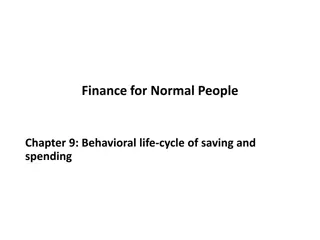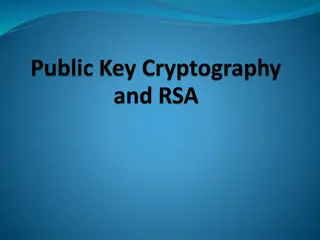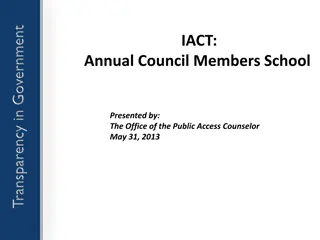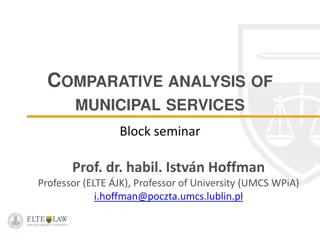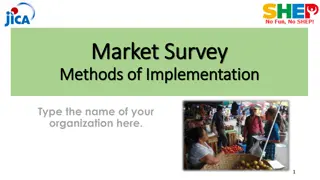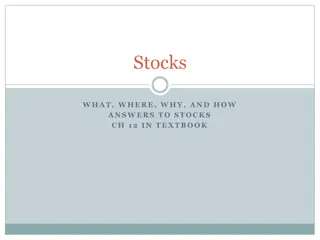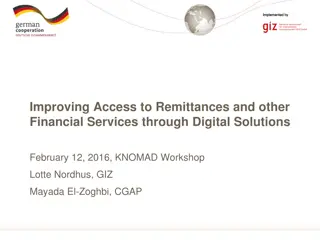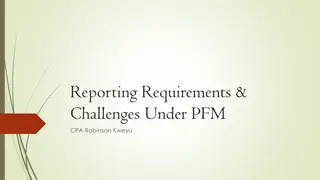Understanding Private vs. Public Saving and Financial Market Dynamics
Explore the concepts of private and public saving in relation to national income, expenditure, and government fiscal policies. Delve into the analysis of saving, investment, financial markets, and the impact of real interest rates on loanable funds. Gain insights into the relationships between saving, investment, and government budget deficits/surpluses.
Download Presentation

Please find below an Image/Link to download the presentation.
The content on the website is provided AS IS for your information and personal use only. It may not be sold, licensed, or shared on other websites without obtaining consent from the author. Download presentation by click this link. If you encounter any issues during the download, it is possible that the publisher has removed the file from their server.
E N D
Presentation Transcript
Todays Plan Learning Activity A: Private Saving vs. Public Saving Discussion NZ Superannuation Scheme Learning Activity B: Saving, Investment and Financial Markets Discussion Investment tax credit vs. Government budget deficit Workshop Quiz 1
A. Private Saving vs. Public Saving Some identities GDP identity: In a closed economy, no trade => NX = 0 What is saving? Define saving as current income minus expenditure on current needs. Current national income: Y (GDP) Expenditure on current needs: C + G S = Y C G S = I Y = C + I + G + NX Y = C + I + G I = Y C - G 2
A. Private Saving vs. Public Saving Splitting national saving into two parts Start with the definition of National saving (S): S = Y C G Add and subtract Net Taxes (T): S = Y C T + T G Re-arrange the terms: S = (Y T C) + (T G) National Saving Private Saving Public Saving Spublic Sprivate = Household Saving + Business Saving 3
A. Private Saving vs. Public Saving Budget Surplus and Deficit Public saving: Balanced Government Budget: Government Budget (Fiscal) Deficit: excess of government spending over tax collections T < G and Spublic < 0 Government Budget (Fiscal) Surplus: T > G and Spublic > 0 the government budget surplus (T G) equals public saving Spublic = T G T = G and Spublic = 0 4
B. Saving, Investment and Financial Market Demand-Supply Analysis People s decisions to save and or invest can be modelled with our simple supply and demand model by making some general simplifications. Financial markets coordinate the economy s saving and investment in the market for loanable funds. Loanable funds: all income that people have chosen to save and lend out, rather than use for their own consumption. The supply of loanable funds: households and firms who have extra income they want to save and lend out. The demand for loanable funds: households and firms that wish to borrow to make investments. 5
B. Saving, Investment and Financial Market Demand-Supply Analysis Real Interest Rate Why does the demand for loanable funds decrease with the real interest rate? Interest payment is the COST of borrowing; so when interest rate goes up (down) the cost of borrowing goes up (down) 5% Demand (Investment) With higher (lower) interest rates people borrow less (more). Loanable Funds ($ billions) 0 $1,200 6
B. Saving, Investment and Financial Market Demand-Supply Analysis Real Interest Rate Why does the supply of loanable funds increase with the real interest rate? Supply S=Y-C-G Interest payment is the EARNING from savings. 5% So when interest rate goes up (down) people are inclined to save more (less). Loanable Funds ($ billions) 0 $1,200 7
B. Saving, Investment and Financial Market Demand-Supply Analysis Real Interest Rate Supply S=Y-C-G In the market for loanable funds, the real interest rate equates the quantity of saving supplied and demanded. 5% Demand (Investment) Loanable Funds ($ billions) 0 $1,200 8
B. Saving, Investment and Financial Market Discussion: Impacts of an investment tax credit Real Interest Interest rate will go up Rate Suppose the government offers investment tax credits so that firms pay lower tax on funds invested in new productive capacity. Supply (Saving=Y-C-G) 5% How does this policy affect the curves in the market for loanable funds? Demand (Investment) How does the interest rate change? Loanable Funds ($ billions) 0 $1,200 Quantity of funds goes up 9
B. Saving, Investment and Financial Market Discussion: What if the government runs budget deficit? Real Interest Rate Suppose the government runs budget deficits. Supply (Saving=Y-C-G) How do budget deficits affect the curves in the market for loanable funds? 5% How does the interest rate change? Demand (Investment) Loanable Funds ($ billions) 0 $1,200 10
Why do people save? Since the 1900s, improvements in medical and nutrition conditions have allowed people to live much longer than before. Should people save more than before? 11
Discussion: NZ Superannuation Scheme How much does the currently old generation get per year? ????????????? ?????? ??????? How much does the currently young generation pay per year? ??????????????? ?????? ???????????? Suppose NZ government needs to balance the budget on this scheme. ????????????? ?????? ??????? = ??????????????? ?????? ???????????? What does this scheme look like? During your entire career, you need to contribute via the income tax. For someone who starts working at 18, in 47 years, you will be eligible for collecting the weekly payment. What may affect the rate of return to this scheme? 13
Discussion: NZ Superannuation Scheme Given the rising life expectation and the falling fertility rate (children per women), what kind of challenges will NZ government face in the future? ? ????????????? ?????? ???????= ??????????????? ?????? ???????????? If you are Chief Economic Advisor of NZ Treasury, can you offer some policy solutions to the problem of ageing population? How would these policies affect your current saving decision? 14
Discussion: NZ Superannuation Scheme ????????????? ?????? ??????? = ??????????????? ?????? ???????????? Raise ???????????????? Raise the Annual Contribution? Reduce Annual Payment? Reflections on designing public policies Did NZ government anticipate the population ageing when it first introduced the superannuation scheme in 1970s? The life expectancy and the fertility rate at that time? 15
Socrative.com Chaudhuri251 16
Question #1 Suppose the nominal interest rate on savings deposits in 3% and inflation is running at 5%. Which of the following statements is true? We know that Real interest rate = Nominal Interest rate Inflation rate So, Real interest rate = 3% - 5% = (-)2% This means if you save your money then it will lose value over time; it is almost as if $100 today will be worth $98 in one year. So, you are better off spending your money now rather than saving it. 17
Question #2 In a closed economy, what does (Y - T - C) represent? Private saving 18
A. Private Saving vs. Public Saving Splitting national saving into two parts Start with the definition of National saving (S): S = Y C G Add and subtract Net Taxes (T): S = Y C T + T G Re-arrange the terms: S = (Y T C) + (T G) National Saving Private Saving Public Saving Spublic Sprivate = Household Saving + Business Saving 19
Question #3 Suppose that in a closed economy GDP is equal to 8,000. Consumption equals 5,000 while Investment is 1,000. What is the value of Government expenditure? We know that in a closed economy Y (GDP) = C + I + G IF Y = 8000, C = 5000 and I = 1000 then Y = C + I + G implies 8000 = 5000 + 1000 + G Or G = 2000. 20
Question #4 Suppose that in a closed economy GDP is equal to 8,000, Taxes are equal to 2,000, Consumption equals 5,000, and Government expenditures equal 1,000. How much is private saving? How much is public saving? How much is national saving? Private saving = Y T C = 8000 2000 5000 = 1000 Public saving = T G = 2000-1000 = 1000 National saving = Private Saving + Public Saving = 2000 21
Question #5 What would happen in the market for loanable funds if the government were to increase the tax on income earned from interest paid on savings? If interest income is taxed then savings become less attractive. This will lead to a reduction in saving and therefore, the supply of loanable funds. 22
Question #5 Interest rate will rise from 5% to something higher Real Interest Rate If interest income is taxed then this will reduce the supply of loanable funds and result in an increase in the real interest rate Supply (Saving=Y-C-G) 5% Demand (Investment) Loanable Funds ($ billions) 0 $1,200 Quantity of funds drops 23
Question #6 Suppose the government institutes an investment tax credit. What would happen in the market for loanable funds? This makes investment more attractive and create an increase in the demand for loanable funds. Demand for loanable funds will shift to the right. 24
Question #6 Interest rate will rise from 5% to something higher Real Interest Rate Supply (Saving=Y-C-G) If investment becomes more attractive then demand for loanable funds shifts to the right resulting in an increase in the interest rate. 5% Demand (Investment) Loanable Funds ($ billions) 0 $1,200 Quantity of funds increases 25
Question #7 A higher interest rate induces people to: Save more and hence the supply of loanable funds slopes upwards. Invest less and hence the demand for loanable funds slopes downwards. 26
Question #8 If Taxes > Government spending Then we have public (government) saving. If Taxes < Government spending Then we have a budget deficit. 27
Review of Learning Outcomes Upon successful completion of this week s module, you should be able to: distinguish between private and public saving, explain the role of the loanable funds market in coordinating saving and investment, explore the impacts of population ageing on NZ superannuation scheme and on individual saving decision 28
An acquaintance is asking you to buy bonds of a new start-up. If you invest $1000 then they will return $1200 in two years time. The current real interest rate is 10% and will remain unchanged in the foreseeable future. Should you buy this bond? 29
If interest is paid each year, and if the interest paid remains in the bank account to earn more interest (a process called compounding) then the $100 will become: (1+ r) x $100 after one year. After 2 years, the amount becomes (1+r) x (1+r) x $100 = (1+r)2 x $100 After 3 years, it will become (1+r) x (1+r) x (1+r) x $100 = (1+r)3 x $100 30
Suppose interest rate is 5%. Start with $1000. At the end of the year: $1000 + 0.05X$1000 = $1000X(1+0.05) = $1050 At the end of second year: $1050 + 0.05X$1050 = ($1000 + 0.05X$1000) + 0.05 ($1000 + 0.05X$1000) = ($1000 + 0.05X$1000)(1 + 0.05) = $1000X(1.05)(1.05) At the end of the third year the amount becomes $1000X(1.05) x (1.05) x(1.05) = (1.05)^3x $100 After 4 years, it will become $1000X(1.05)^4 31
After 10 years then the amount will be: (1+r)10 x $100. If the interest rate is 5%, i.e., r = 0.05 then the amount after 10 years will be: (1+0.05)10 x 100 = (1.05)10 x 100 = $163. In general then, after N years the amount will be: (1+r)N x 100 If r = 0.05 then this is equal to (1.05)N x100 32
Question: Now suppose you are going to be paid $200 in 10 years. What is the present value of this investment? That is how much would you have to invest to get $200 in 10 years? Answer: To answer this question turn the previous answer on its head 33
If r = 0.05 then this works out to: $200/(1.05)10 = $123. Another way to think of this is the following: Suppose the present value of $200 in 10 years is $X. Then it must be the case that: (1+r)10 x $X = $200 Rearranging this equation means that: $X = $200/ (1+r)10 Again if r = 0.05 then this is equal to: $200/ (1.05)10 = $123. 34
You have the option of making the following investment. You can buy a bond for $1000 and the bond will pay you $1200 in two years time. The current real interest rate is 10% and will remain unchanged in the foreseeable future. Should you buy this bond? 35
No. Why? In 2 years time $1000 will become $1000 (1.1)^2 = $1210 which is bigger than $1200. You are better off investing the $1000 elsewhere at 10%. Or Net Present Value of $1200 in two years = $1200/(1.1)^2 = $992. So you should buy the bond if and only if you can buy it for $992 or less. But if current price more than $992 then do not buy the bond. You will do better getting 10% elsewhere. 36






















